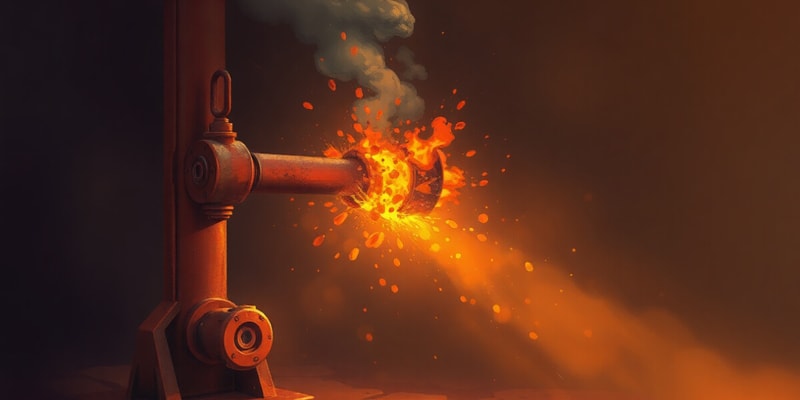Podcast
Questions and Answers
What is the primary chemical process involved in rusting?
What is the primary chemical process involved in rusting?
Which of the following conditions is essential for rusting to occur?
Which of the following conditions is essential for rusting to occur?
What does rust primarily consist of?
What does rust primarily consist of?
Which factor is most likely to accelerate the rusting process?
Which factor is most likely to accelerate the rusting process?
Signup and view all the answers
Which method is NOT an effective prevention strategy for rusting?
Which method is NOT an effective prevention strategy for rusting?
Signup and view all the answers
What is a major economic impact of rusting?
What is a major economic impact of rusting?
Signup and view all the answers
How does galvanization help in preventing rusting?
How does galvanization help in preventing rusting?
Signup and view all the answers
Which of the following can also corrode besides iron?
Which of the following can also corrode besides iron?
Signup and view all the answers
Study Notes
Overview of Rusting
- Rusting is a chemical process involving the corrosion of iron and its alloys.
- It commonly appears as a reddish-brown flaky coating, referred to as iron oxide.
Conditions for Rusting
- Presence of water: Essential for rusting to occur; acts as a medium for the electrochemical reactions.
- Oxygen: Reacts with iron in the presence of moisture.
- Electrolytes: Saltwater or acidic conditions accelerate rusting.
Process of Rusting
- Oxidation of Iron: Iron (Fe) loses electrons to form iron ions (Fe²⁺).
- Formation of Hydroxide Ions: Oxygen from the air reacts with water to form hydroxide ions (OH⁻).
- Formation of Rust: Iron ions react with hydroxide ions, leading to the formation of hydrated iron(III) oxide (Fe2O3·nH2O), commonly known as rust.
Factors Affecting Rusting
-
Environmental Conditions:
- Humidity: Higher humidity increases the rate of rusting.
- Temperature: Higher temperatures generally accelerate rusting.
- Alloy Composition: Various alloying elements can enhance or reduce corrosion resistance.
- Protective Coatings: Paints, oils, and galvanization can prevent rusting.
Prevention Methods
- Coatings: Application of paint or other protective layers.
- Galvanization: Coating iron with zinc to prevent moisture exposure.
- Dehumidification: Reducing moisture in the environment.
- Use of Corrosion Inhibitors: Chemicals that slow down the rusting process.
- Cathodic Protection: Using sacrificial anodes to protect iron structures.
Impact of Rusting
- Economic Loss: Significant cost associated with infrastructure repair and replacement.
- Safety Hazards: Rusting can lead to structural failures and accidents.
- Aesthetic Damage: Rust can diminish the appearance of metal objects, leading to decreased property value.
Rusting in Other Metals
- While primarily associated with iron, other metals such as aluminum and copper can also corrode but form different compounds (e.g., aluminum oxide, copper patina).
Summary
- Rusting is an electrochemical process accelerated by moisture and oxygen.
- Preventive measures are crucial for extending the life of metal structures and reducing economic impact.
Rusting
- A chemical process that involves the corrosion of iron and its alloys
- Appears as a reddish-brown flaky coating called iron oxide
Conditions for Rusting
- Water is essential for rusting to occur
- Acts as a medium for the electrochemical reactions
- Oxygen must be present
- Reacts with iron, but only when in contact with moisture
- Electrolytes accelerate the rusting process
- Saltwater or acidic conditions increase the rate of rusting
Process of Rusting
- Oxidation of iron
- Iron atoms lose electrons and form iron ions (Fe²⁺)
- Formation of Hydroxide Ions
- Oxygen from the air reacts with water to form hydroxide ions (OH⁻)
- Formation of Rust
- Iron ions react with hydroxide ions, forming hydrated iron(III) oxide (Fe2O3·nH2O)
- This is commonly called rust
- Iron ions react with hydroxide ions, forming hydrated iron(III) oxide (Fe2O3·nH2O)
Factors Affecting Rusting
- Environmental conditions
- Humidity increases the rate of rusting
- Higher temperatures generally accelerate rusting
- Alloy composition
- Different alloys have varying levels of corrosion resistance
- Protective coatings
- Paints, oils, and galvanization can prevent rusting
Prevention Methods
- Coatings
- Applying paint or other protective layers
- Galvanization
- Coating iron with zinc to prevent moisture exposure
- Dehumidification
- Reducing moisture in the environment
- Corrosion Inhibitors
- Chemicals that slow down the rusting process
- Cathodic Protection
- Using sacrificial anodes to protect iron structures
Impact of Rusting
- Economic loss
- Costs related to infrastructure repair and replacement
- Safety hazards
- Rusting can lead to structural failures and accidents
- Aesthetic damage
- Rust can diminish the appearance of metal objects, leading to decreased property value
Rusting in Other Metals
- Although primarily associated with iron, other metals also corrode
- Aluminum and copper can corrode but form different compounds
- Aluminum oxide and copper patina
- Aluminum and copper can corrode but form different compounds
Summary
- Rusting is a destructive process caused by the electrochemical reaction between iron, water, and oxygen.
- Preventive measures are essential to extend the life of metal structures and reduce economic impact.
Studying That Suits You
Use AI to generate personalized quizzes and flashcards to suit your learning preferences.
Description
This quiz delves into the chemical process of rusting, detailing how iron and its alloys corrode. Participants will learn about the conditions necessary for rusting, the process itself, and the various environmental factors that influence the rate of rust formation.



